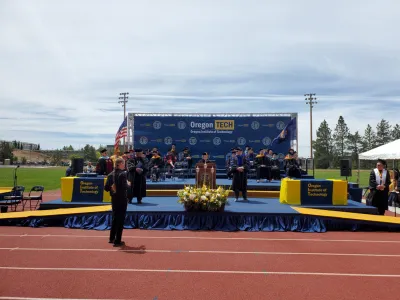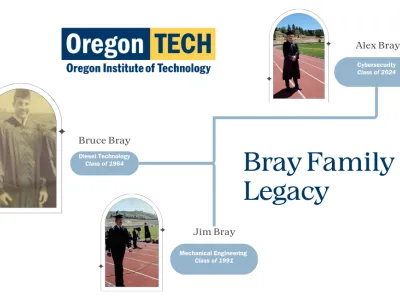Record 91,850 students enroll in Oregon's public universities
by Suzanne Pardington, The Oregonian
Nov. 10, 2009
Enrollment in Oregon's seven public universities hit a record 91,580 students this fall despite state budget cuts and tuition hikes, but fewer of the new students are freshmen, officials announced Tuesday.
For the second year in a row, enrollment grew by more than 5 percent, putting pressure on campuses to serve more students as state funding drops.
George Pernsteiner, chancellor of the Oregon University System, called the enrollment growth a "silver lining" in the recession.
"I think it's really good news for Oregon that students are going to school," he said. "It is now incumbent on us to help them get through, and I think it will be to the long-term benefit of the state."
That's hard to do after the Legislature cut state funding for Oregon universities by 9 percent, Pernsteiner said.
Tuition increases from 3.5 percent at Eastern Oregon University to 15 percent at the University of Oregon don't seem to have deterred many students from enrolling or transferring to Oregon's universities.
The University of Oregon's tuition and fees this fall are $7,428 a year for full-time in-state undergraduates, the highest of the state's seven public universities.
Enrollment numbers are up at every campus, including an 8.4 percent increase at Oregon State University, 5.2 percent at Portland State University and 4.1 percent at the University of Oregon.
Katie Slayden, an 18-year-old freshman from Eugene, said the economy played a role in her decision to enroll at Portland State.
She originally wanted to attend Lewis & Clark College, but her family couldn't afford it after her father's home remodeling business dropped with the housing market.
"Two years ago, if I were applying to college, I might have gone to Lewis & Clark, but we definitely do not have the money," she said.
The biggest jump was at Oregon Institute of Technology, which has 3,927 students this fall, an 11.4 percent increase. Eastern Oregon University in La Grande, which has struggled with enrollment in recent years, has nearly 8 percent more students this fall.
The universities saw gains in international, transfer and graduate students. But the number of freshmen fell slightly to 11,512 students, 63 fewer than last year.
The University of Oregon limited its freshman class on purpose after an unexpected surge overwhelmed the campus last fall. About 400 fewer freshmen enrolled this fall at UO.
The recession may have pushed some freshmen to start at community colleges, where enrollment is surging and tuition is lower.
Nearly 82 percent of freshmen returned for their sophomore year, up from just less than 80 percent last year and an all-time high. Some students who might have dropped out are staying in school because they can't get jobs, officials said.
Ty McKnight, 19, a sophomore from California who pays out-of-state tuition, said he plans to take classes next summer instead of going home to work because he was pushed out of his regular summer job by older workers.
Some of his friends have dropped out to attend Portland Community College because it's less expensive, he said.
"The economy has taken its toll on everybody," he said.
He never considered going back to California, because "I thought I'd get a better education here," he said.
Transfer students increased by 11 percent, a trend Pernsteiner expects to continue as community college enrollment grows.
"The real trick now for all of us is to sustain the momentum to be able to provide the support for students and the funding to the campuses that will allow us to move those students through to completion of degree," he said.
Visit the Oregon University System page to view the full report.








